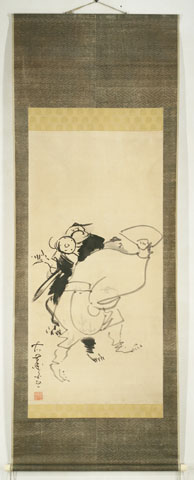haiga
Manzai dancersSigned: Yû Shôhaku ga
Seals: Dasokken Shôhaku
Technique: sumi on paper 110,8 x 54,6
Mounting: green damask 185,5 x 68,2
Condition: very good
Shôhaku was born in Kyoto to a merchant family. In his early twenties he studied with the old Kanô style painter Takada Keihô (1674-1755). Keihô's influence was profound, which must have helped him a lot, because his career was already set in his early thirties. His prolonged stay at Ise in 1758-1759 seemed to have made him popular there because he returned in 1764 and went to Harima in 1767. Some of his best work was made on these trips of which many commissions for Buddhist temples.
Shôhaku was one of the three so-called independents, Shôhaku, Itô Jakuchû (1716-1800) and Nagasawa Rosetsu (1754-1799). He was a hell of a painter and a character. He felt undervalued which he compensated with bold and eccentric work as a result his contemporaries considered him mad and fanatic. He made up a number of fictitious descents from the Soga lineage up to the founder of the Ming dynasty making him 14th generation Emperor of China. It didn't really help.
Shôhaku's work is a mixture of Kanô School painting, Soga, Unkoku, Muromachi and early Chinese paintings, often picturing Chinese subjects and Muromachi type landscapes done in broad ink washes in combination with detail. Shôhaku had no formal schooling, no (proven) cultural or historical lineage and after his early death no one to follow him in his art. Seems typical, makes it tragically.
Reference:
Chiba 1998
Kyoto 2005
Nihon no bijutsu kaiga kinshû vol. 23
Roberts p. 150
Rosenfield B 85
Price: ON REQUEST

